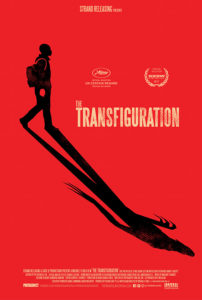Upon seeing The Transfiguration, it’s apparent that the film’s director and writer, Michael O’Shea, wanted the audience to feel as uncomfortable as possible. The first scene leaves a sick feeling that only gets further exacerbated as the film goes on. One of the primary reasons for this is that the movie is pretty damn good. From the script to the performances, there is a genuine craft on display throughout the entire picture.
The movie follows a young African-American teenager named Milo (Eric Ruffin) who, believing himself to be a vampire, forms a bond with another teenager named Sophie (Chloe Levine). They both reside in a poor neighborhood and have troubled pasts. While they both suffer from mental issues due to their backgrounds, Milo is deeply disturbed. The audience is made aware of this fact early on and almost every scene progressively presents how psychotic he really is. Sophie on the other hand suffers from the fate of her circumstances, and her scenes progressively convey how much worse her situation gets. Interestingly enough, the audience is presented with a dichotomy because as we emotionally distance ourselves from Milo, we become more empathetic towards Sophie.
An honest comparison to make with this film is with Let the Right One In, especially since it is referenced multiple times. The movie is a coming of age story dealing with outcasts that incorporates horror elements. Milo truly believes that he is a vampire and acts as such. He conducts vile acts that are uncomfortable to watch in the least. So, when we see Milo and Sophie there is a constant aura of tension because it is a relationship that we really do not want to see progress.
Two elements that contribute to the uneasy feeling contracted from the screen are the score and the sound. There are moments when Milo is sneaking up on his victims and the score is perfectly synced to convey the intensity of the upcoming violent act. The element that is the most disturbing aspect of the film is the sucking sound emitted from Milo when he consumes blood. That sound will ring through your body and stick with you like a vengeful earwig. The uneasiness is further enhance by the special effects. There are many scenes of violence and the filmmakers deliver by providing blood and gore that looks real. Every violent act is cringe-inducing and visceral.
Aside from the horrific aspect, the film has a very naturalistic component. The camera utilizes a shaky-style but it’s not overbearing and it retains the intimacy without the documentary look. The movie takes place in New York and the film portrays it in the most moderate way. There is no romanticism nor emphasis on grittiness because we mostly see streets, apartments, and the insides of subway cars. The performances from the cast portray the characters with honesty with the only extreme coming from Ruffin. It is appropriate in his case because he is playing a sociopath who lacks empathy and has awkward speech patterns. The performances are further enhanced by the excellent script. Not only does the dialogue comes off as natural and real, but the plot progresses in an honest way.
The greatest flaw facing this film is one that affects many coming of age stories, and that is the pacing. There are many shots that carry on for way too long and there some that are completely superfluous. The ending is the biggest proponent of this flaw in that there should have been stricter editing. It drags on and there are too many scenes that do not add to the final moment which is powerful in itself.
The Transfiguration is a disturbing coming of age story that will definitely leave an impression on anyone who sees it. With the exception of the pacing, the filmmaking and acting succeeds in spades. While it’s definitely not a movie for everyone, (or most for that matter) it is still a thoughtful and pretty well-executed blend of genres.
The Transfiguration will open April 7, 2017 at the Angelika Film Center in New York and will go on to have a national release.









